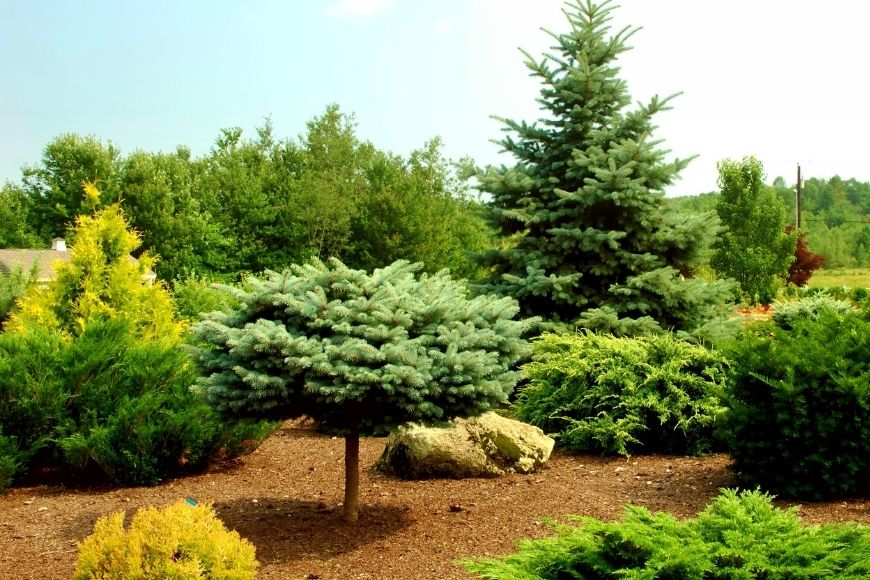
When it comes to keeping your landscape glowing through the coldest and grayest months of the year, evergreens can’t stop, won’t stop! Not only do evergreens keep your yard verdant and beautiful, but they also provide cover and food for wildlife. Evergreens can also do double duty by providing privacy, windbreak, and a backdrop for your holiday decor.
So, if you’ve been feeling a bit green with envy admiring your neighbor’s evergreens--don’t worry. This article will give you a bit of guidance for adding evergreens to your yard in an effective and attractive way.
Selecting Evergreens for Your Landscape
Before you order an army of shrubs and trees, you will want to carefully plan out what varieties you will want, how many, and be sure your yard can handle them.
One of the most lovely aspects of evergreens is they come in all shapes, sizes, textures, and shades. However, they also grow at different rates and need varying conditions.
So, you will want to spend a bit of time deciding what aesthetic best reflects your taste, and how much maintenance you have time for (and want to make time for).
Slow-Growing vs Fast-Growing
Fast-growing evergreens come with the benefit of becoming established sooner. You can also buy more petite plants because they will grow quickly to reach mature heights--perfect for privacy hedges.
Keep in mind that fast-growing evergreens will need to be pruned and shaped more often.
Fast-Growing Evergreens:
- Thuja Green Giant
- Thuja occidentalis
- Leyland Cypress
- Oakleaf Holly
- Gold Lace Juniper
- Blue Italian Cypress
- Canadian Hemlock
Slow-growing evergreens often grow to soaring sizes and offer a low-maintenance way to watch your landscape relax into a lush and established scene.
Slow-Growing Evergreens:
- Inkberry holly
- Fire Chief Arborvitae
- Varigated Boxwood
- Compact Japanese holly
- Bird’s Nest Spruce
- Blue Rug Juniper
Selecting Color
When it comes to evergreens, you can find shades of green, yellow, blue, and gray foliage. And, of course, there are also variegated choices. We always find contrast provides long-lasting interest and allows each of your evergreens to stand out individually.
Deeper greens contrast well with lighter exterior paint colors as foundation plantings. If you use dark greens as your back planting, consider yellows, grays, or softer greens as accents.
Grays, yellows, and blues stand out against brick and darker exteriors.
Berries and Blooms
One of the greatest gifts of evergreen is their abundant berries. Hollies, winterberry, and beautyberry all offer phenomenal pops of clustered berries all winter long. Not only do these berries add whimsy and fun to winter, but birds depend on them for their winter diet.
You can even find some evergreens that bloom in winter (or other seasons). Camellias are a top choice for winter-blooming evergreen shrubs. Yuletide Camellias product glowing red blooms with yellow centers, and Shishi Gashira Camellias come alive with blazing pink double blooms.
Rhododendrons are a wonderful choice for gardeners needing a shade-friendly evergreen that prefers rocky terrain and damp soil. Most have lovely deep green foliage with expressive forms.
Size and Shape
When planning your evergreen landscape, take into account how wide, tall, and what habit or form your plants and trees will take.
Account for how tall and wide your evergreens will become. Always err on the side of providing them extra space when it comes to foundation plantings. Additionally, always be mindful of power lines. You do not want branches or the top of your shrubs or trees to come in contact with lines.
Pairing low-growing or creeping evergreens with round medium evergreens, and tall pillar-like evergreens is always attractive. Consider keeping your height and width differences to a 1-to-3 ratio between your plants.
Texture
In addition to combining a variety of sizes and shapes of shrubs for a balanced compilation of evergreens, you will likely want to choose a variety of foliage textures.
You will find that evergreens can have soft, fan-like leaves, gentle needles, glossy green leaves, and short, pointy needles. A medley of these textures can add a great deal of depth and interest to your landscaping.
For sharper foliage, we recommend placing these plants in areas where you have plenty of room to maneuver around them without getting poked, gouged, or cut.
However, you can also use these evergreens to your advantage for keeping away unwanted wildlife or strangers by placing them strategically as a property boundary.
Quantity
When laying out and designing your landscape, stick to the rule of three or odd numbers. They tend to be more visually appealing. Of course, symmetry around your entryway can also be quite attractive.
There’s no need to be envious of your neighbors’ evergreens. Adding your own to your yard will provide enduring year-long beauty, interest, and excitement to your yard.
Explore your options, envision your ideal landscape, and don’t wait to order. Winter and early spring are two of the best times to add shrubs and trees to your yard.
Happy planting!
